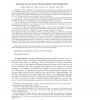Free Online Productivity Tools
i2Speak
i2Symbol
i2OCR
iTex2Img
iWeb2Print
iWeb2Shot
i2Type
iPdf2Split
iPdf2Merge
i2Bopomofo
i2Arabic
i2Style
i2Image
i2PDF
iLatex2Rtf
Sci2ools
SWAT
1998
Springer
1998
Springer
Formal Language Constrained Path Problems
Given an alphabet , a (directed) graph G whose edges are weighted and -labeled, and a formal language L , the formal-language-constrained shortest/simple path problem consists of finding a shortest (simple) path p in G complying with the additional constraint that l(p) L. Here l(p) denotes the unique word obtained by concatenating the -labels of the edges along the path p. The main contributions of this paper include the following: (1) We show that the formal-language-constrained shortest path problem is solvable efficiently in polynomial time when L is restricted to be a context-free language (CFL). When L is specified as a regular language we provide algorithms with improved space and time bounds. (2) In contrast, we show that the problem of finding a simple path between a source and a given destination is NP-hard, even when L is restricted to fixed simple regular languages and to very simple classes of graphs (e.g., complete grids). (3) For the class of treewidth-bounded graphs, w...
| Added | 06 Aug 2010 |
| Updated | 06 Aug 2010 |
| Type | Conference |
| Year | 1998 |
| Where | SWAT |
| Authors | Christopher L. Barrett, Riko Jacob, Madhav V. Marathe |
Comments (0)

